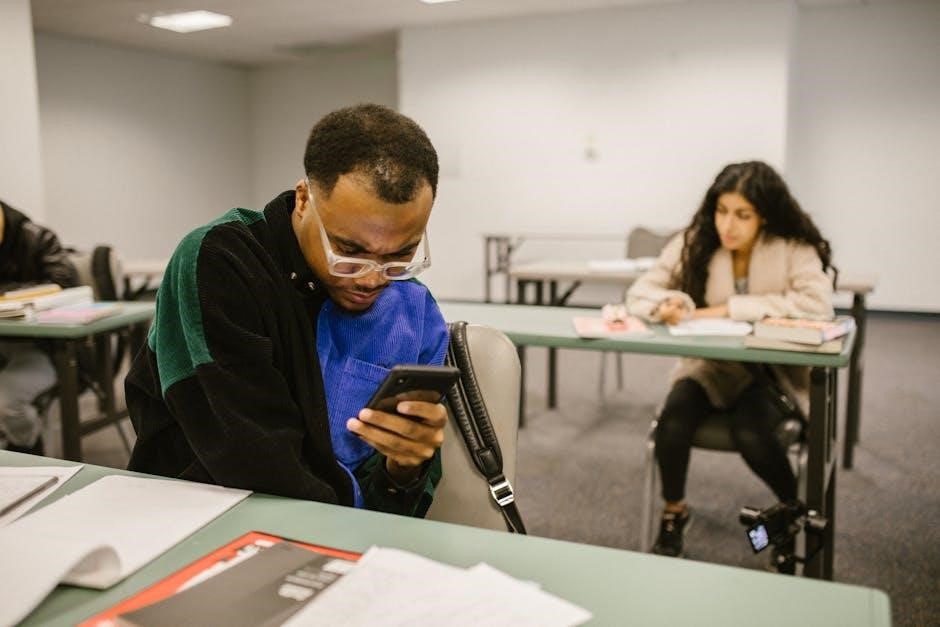The Mini-BESTest is a concise assessment tool focusing on dynamic balance evaluation, designed for clinical use in rehabilitation and physical therapy settings to measure balance impairments effectively․
1․1 Definition and Purpose
The Mini-BESTest is a streamlined balance assessment tool designed to evaluate dynamic balance abilities in individuals, particularly those with motor impairments․ Derived from the original BESTest, it focuses on key aspects of balance control, such as transitions, mobility, and cognitive-motor interactions․ Its primary purpose is to provide a quick yet comprehensive evaluation of balance deficits, aiding clinicians in developing targeted rehabilitation strategies․ Administered in approximately 15 minutes, the Mini-BESTest is a practical and efficient tool for use in clinical and physical therapy settings, offering insights into balance impairments and monitoring progress over time․

1․2 Importance of Balance Assessment
Balanced assessment is crucial for identifying impairments and preventing falls, especially in aging populations and those with neurological or motor conditions․ Effective balance evaluation tools like the Mini-BESTest help clinicians understand an individual’s risk of falling and design appropriate interventions․ Early detection of balance deficits can significantly improve rehabilitation outcomes, enhancing quality of life and reducing healthcare costs․ By focusing on dynamic aspects of balance, such as transitions and cognitive-motor interactions, the Mini-BESTest provides valuable insights into functional mobility and overall physical stability, making it an essential component of comprehensive rehabilitation programs․

Components of the Mini-BESTest
The Mini-BESTest evaluates dynamic balance, transitions, and mobility, focusing on cognitive-motor interactions to assess functional stability and predict fall risk in individuals with balance impairments․
2․1 Dynamic Balance Assessment

The Mini-BESTest evaluates dynamic balance through tasks that challenge stability and mobility, such as reaching, turning, and changing direction․ These activities mimic real-life movements, assessing how individuals adapt to changing environments while maintaining equilibrium․ The test observes movement strategies, including weight transfer and postural adjustments, to identify impairments․ Scoring reflects the ability to perform tasks smoothly and efficiently․ This component is crucial for understanding fall risk and guiding rehabilitation strategies to improve functional balance and overall mobility in clinical settings․
2․2 Transitions and Mobility
The Mini-BESTest evaluates transitions and mobility by assessing how individuals move between positions, such as sitting to standing or walking․ These tasks measure the ability to initiate and control movements smoothly․ Transitions are critical for daily activities and fall prevention․ The test includes actions like walking, turning, and changing direction, which reflect real-life challenges․ Scoring focuses on the ease and coordination of these movements․ This section helps clinicians identify mobility limitations and design targeted interventions to enhance functional independence and reduce fall risks in rehabilitation settings․ It complements dynamic balance assessment by focusing on the practical application of balance during movement transitions․
2․3 Cognitive-Motor Interactions
Cognitive-motor interactions in the Mini-BESTest examine how cognitive functions influence motor tasks․ This section assesses dual-task performance, requiring individuals to complete balance-related activities while performing cognitive tasks․ Examples include walking while counting or following instructions․ The evaluation measures how divided attention affects balance and coordination․ This interaction is crucial, as real-world environments often demand simultaneous cognitive and motor engagement․ Impaired cognitive-motor interaction can indicate increased fall risk․ The test provides insights into the neural integration of cognitive and motor systems, aiding in the development of targeted rehabilitation strategies to improve both balance and cognitive function in individuals with motor impairments or neurological conditions․

Administration and Scoring
The Mini-BESTest involves step-by-step administration procedures, with a standardized scoring system to assess balance accurately․ It typically takes 15 minutes to complete, focusing on dynamic balance tasks․
3․1 Step-by-Step Administration Guide
The Mini-BESTest is administered in a structured manner, starting with participant preparation․ Ensure the individual stands barefoot or in non-slip footwear․ Begin with a series of dynamic balance tasks, such as standing on one leg and walking with eyes closed․ Each task is demonstrated and explained clearly․ The administrator observes and records performance, noting ability, balance strategies, and any compensations․ The test progresses through increasingly challenging activities to assess various aspects of balance control․ Proper documentation of each step ensures accurate scoring and reliable results, facilitating effective clinical decision-making and rehabilitation planning․
3․2 Scoring Criteria and Interpretation
The Mini-BESTest uses a 16-point scale, with each task scored from 0 to 2, reflecting the individual’s ability to perform dynamic balance activities․ Higher scores indicate better balance control․ Scores are interpreted based on established cutoffs, with lower values suggesting increased fall risk․ Clinicians analyze performance across tasks to identify specific impairments, such as poor stability during transitions or difficulty with cognitive-motor interactions․ The total score provides a comprehensive overview of balance function, guiding rehabilitation strategies and monitoring progress over time․ Clear scoring criteria ensure reliability and consistency in clinical and research applications, making the Mini-BESTest a valuable assessment tool․

Comparison with Other Balance Tools
The Mini-BESTest is a more efficient and dynamic balance assessment compared to traditional tools, focusing on functional tasks and providing a comprehensive evaluation of balance impairments in clinical settings․
4․1 Mini-BESTest vs․ BESTest
The Mini-BESTest is a shortened version of the original BESTest, designed to assess balance in a more efficient manner․ While the BESTest is comprehensive, covering 36 items across six sections, the Mini-BESTest focuses on 14 key items, emphasizing dynamic balance and functional tasks․ This reduction allows for quicker administration, typically taking 15 minutes compared to the longer BESTest․ Both tools aim to identify balance impairments, but the Mini-BESTest is more practical for clinical settings where time is limited․ It retains the core elements of the BESTest while streamlining the process, making it a valuable alternative for assessing balance in rehabilitation environments․
4․2 Advantages Over Traditional Methods
The Mini-BESTest offers significant advantages over conventional balance assessments, particularly in its focus on dynamic balance and functional mobility․ Unlike static tests, it evaluates how individuals adapt to changing environments, providing deeper insights into real-world stability․ Its concise structure allows for efficient administration, making it ideal for busy clinical settings․ Additionally, the Mini-BESTest is more patient-centered, reducing fatigue and improving engagement․ It also minimizes the need for specialized equipment, enhancing accessibility․ These features collectively make the Mini-BESTest a practical and effective tool for identifying balance deficits and monitoring progress in rehabilitation, surpassing the limitations of traditional, time-consuming methods․

Clinical Applications
The Mini-BESTest is widely used in rehabilitation and physical therapy settings to assess and improve balance, mobility, and functional abilities in patients with neurological or musculoskeletal conditions․
5․1 Use in Rehabilitation Settings
The Mini-BESTest is a valuable tool in rehabilitation settings, aiding therapists in identifying balance deficits and monitoring progress․ Its concise design allows for efficient assessment, making it ideal for patients with neurological or musculoskeletal conditions․ The test’s focus on dynamic balance helps clinicians tailor interventions to improve mobility and reduce fall risk․ Regular use in rehabilitation enhances functional recovery and supports personalized treatment plans․
5․2 Application in Physical Therapy
In physical therapy, the Mini-BESTest is widely applied to evaluate and improve balance in patients․ It helps therapists design targeted exercises, addressing specific deficits․ The tool is particularly effective for individuals recovering from stroke or trauma, as it assesses transitions and mobility․ By identifying cognitive-motor interactions, therapists can create comprehensive plans to enhance patient stability and coordination․ The test’s simplicity and effectiveness make it a preferred choice in physical therapy, aiding in the restoration of functional abilities and reducing the risk of falls, thus promoting overall patient independence and quality of life․

Research and Evidence
The Mini-BESTest is supported by studies demonstrating its reliability and validity in assessing balance impairments, making it a trusted tool in clinical and research settings․
6․1 Studies Supporting the Mini-BESTest
Research highlights the Mini-BESTest’s effectiveness in assessing balance impairments, with studies demonstrating strong reliability and validity across diverse populations․ It focuses on dynamic balance, transitions, and cognitive-motor interactions, providing comprehensive insights into balance deficits․ Clinical studies have shown its ability to distinguish between individuals with and without balance disorders, making it a valuable tool in rehabilitation settings․ The test’s concise nature, requiring only 15 minutes to administer, enhances its practicality for clinicians․ Evidence supports its use in identifying fall risks and monitoring progress in balance rehabilitation, solidifying its role as a trusted assessment tool in both clinical and research environments․
6․2 Reliability and Validity
The Mini-BESTest has demonstrated strong inter-rater and test-retest reliability, ensuring consistent results across different administrators and testing sessions․ Its validity is supported by strong correlations with other established balance assessment tools․ Studies have shown that the Mini-BESTest accurately measures dynamic balance, transitions, and cognitive-motor interactions, making it a reliable and valid instrument for identifying balance deficits․ The tool’s ability to distinguish between individuals with and without balance impairments further underscores its clinical utility․ These psychometric properties make the Mini-BESTest a trusted and effective assessment tool in rehabilitation and research settings, providing clinicians with accurate and actionable data to guide treatment decisions․

Case Studies and Examples
The Mini-BESTest has been applied in various clinical scenarios, such as post-stroke rehabilitation and geriatric care, demonstrating its effectiveness in improving balance and reducing fall risks effectively․
7․1 Real-World Applications
The Mini-BESTest is widely used in clinical settings to assess balance impairments in patients with neurological or geriatric conditions․ It has proven effective in rehabilitation centers for individuals post-stroke, with Parkinson’s disease, or following traumatic brain injuries․ The test’s brevity and focus on dynamic balance make it ideal for routine assessments․ Clinicians often use it to monitor progress over time, tailoring interventions to address specific deficits․ Its practicality also extends to community-based programs, where it helps identify fall risks early․ Real-world applications highlight its versatility and impact in improving patient outcomes, making it a valuable tool for both assessment and intervention planning․
7․2 Success Stories
The Mini-BESTest has been instrumental in numerous success stories, particularly in rehabilitation settings․ For instance, a patient recovering from a stroke showed significant improvement in balance after tailored interventions based on Mini-BESTest assessments․ Another success story involves an elderly individual with a history of falls, where the test helped identify specific balance deficits, leading to targeted exercises and a marked reduction in fall risks․ These examples highlight the tool’s effectiveness in clinical practice, demonstrating how it aids in personalized treatment plans and enhances patient outcomes․

Future of the Mini-BESTest
The Mini-BESTest is expected to evolve with advancements in technology and clinical research, potentially integrating digital tools and AI for enhanced accuracy and accessibility in balance assessment․
8․1 Emerging Trends
Emerging trends for the Mini-BESTest include the integration of digital tools and AI to enhance assessment accuracy․ Remote assessment capabilities and wearable technology may soon enable real-time balance monitoring․ Advances in data analytics could provide more personalized reports, aiding in tailored rehabilitation plans․ Telehealth platforms may also adopt the Mini-BESTest for remote patient evaluations, improving accessibility․ Additionally, there is a growing interest in incorporating virtual reality for immersive balance training․ These innovations aim to make the Mini-BESTest more efficient, accessible, and effective in clinical and home settings, ensuring better outcomes for patients with balance impairments․ Standardization and clinician-patient interaction remain key focuses․
8․2 Potential Updates and Improvements
Potential updates to the Mini-BESTest may include expanding its scope to assess additional balance-related tasks, enhancing its digital platform for easier administration, and improving its cultural adaptability for global use․ Future revisions could incorporate patient-reported outcomes to provide a more holistic view of balance abilities․ Researchers may also explore integrating wearable technology for real-time data collection during tests․ Additionally, efforts could focus on creating shorter versions for specific populations, such as pediatrics or older adults, while maintaining reliability․ These updates aim to enhance usability, accessibility, and clinical relevance, ensuring the Mini-BESTest remains a gold standard in balance assessment․
The Mini-BESTest is a valuable tool for assessing balance, offering practical insights for rehabilitation and therapy․ Its future evolution will further enhance its clinical utility and applicability․
9․1 Summary of Key Points
9․2 Final Thoughts
The Mini-BESTest stands out as a valuable, efficient tool for balance assessment in clinical and therapeutic settings․ Its focus on dynamic balance, transitions, and cognitive-motor interactions provides a holistic view of a patient’s balance capabilities․ The test’s brevity and ease of administration make it a practical choice for clinicians, while its evidence-based design ensures reliability and validity․ By addressing key aspects of balance impairments, the Mini-BESTest serves as a cornerstone for rehabilitation strategies, fostering improved patient outcomes․ Its adaptability and effectiveness underscore its importance in modern physical therapy and rehabilitation practices, making it a essential resource for healthcare professionals․



